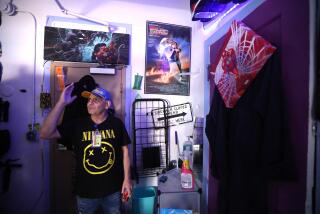Building Fixed Up for Youths Opens
Patrice Starr said she has lived in foster homes since she was 3. But now she is living on her own in a recently refurbished building that used to be a neighborhood blight.
“It’s new--wow!,” said Starr, a 19-year-old Pierce College student, when she first saw the two-bedroom apartment she now shares with two roommates. “I’m the first person who lived here. No one has touched this stuff.”
The “stuff” includes new carpeting, furniture, appliances and framed poster prints. On Friday, government and community leaders gathered to tour the building during its official opening. Resident youngsters entertained the dignitaries with a hip-hop dance routine and a reading of some of their poetry.
The multicolored building on Rayen Street east of Sepulveda Boulevard, is operated by Penny Lane, a nonprofit group that offers housing, classes and counseling for young people with emotional problems.
Crystal Shargots, who said she has lived in foster and group homes all her life, said she needed the new housing.
“If I didn’t have this place, I’d be out, nowhere,” said Shargots, 18, who is one of Starr’s roommates and works at an animal-rescue shelter in Van Nuys. “I never had anyone teach me how to be independent.”
The building is the third complex Penny Lane has opened. The group also administers a main residential home, a school, a clinic, a foster-care agency, administrative offices and nine satellite group homes.
The newly furnished apartments are for young people who grew up in foster care and were left with no home when they became emancipated adults under state law at age 18. Renters must be 18 to 24 years old, work or go to school, and obey rules. No alcohol or drugs are allowed and a nighttime curfew is enforced.
Most renters pay about $350 a month, money that along with interest is returned to them to use for their next apartment, Penny Lane officials said. Twenty-seven young people live in the three buildings and there is a waiting list of about 50.
Ivelise Markovits, Penny Lane’s executive director, said the refurbished buildings were once a crack hangout. “I got really scared with these drug addicts across the street,” she said. “We can’t function with that much drug activity across the street from us.”
Markovits asked for city help to buy and refurbish the building. It cost $210,000 in city-administered Department of Housing and Urban Development funds to do the work, she said.
More to Read
Sign up for Essential California
The most important California stories and recommendations in your inbox every morning.
You may occasionally receive promotional content from the Los Angeles Times.










